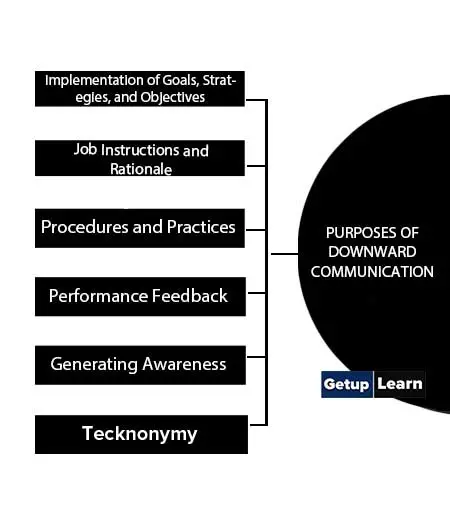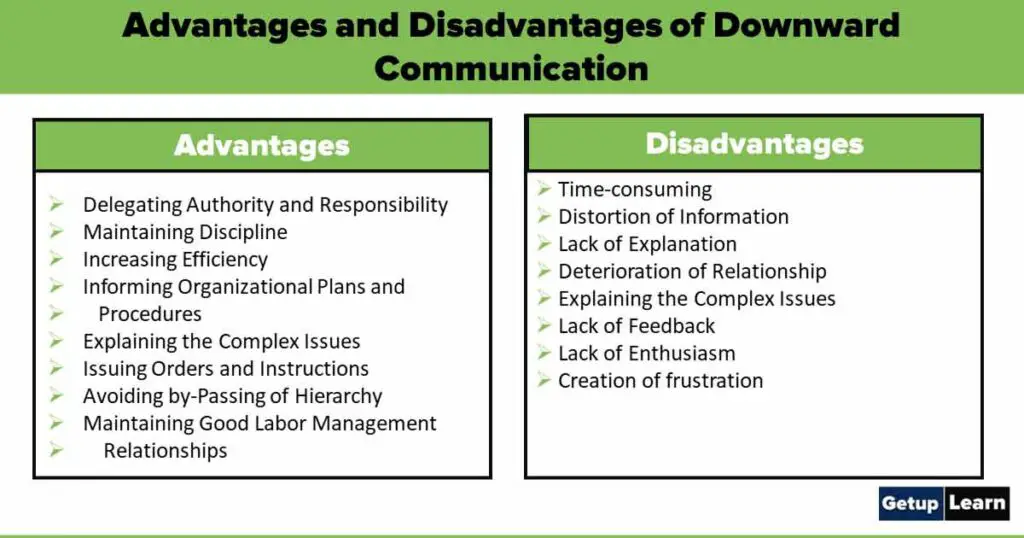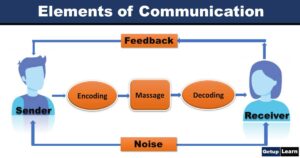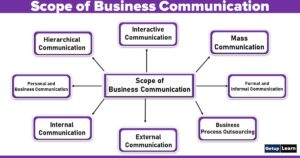Table of Contents
What is Downward Communication?
When the communication is from the superior to subordinates it is referred to as downward communication. This is used for assigning goals, providing job instructions, policies, giving feedback about performance etc. The success of it depends on the skills of the superior, his popularity with subordinates and their level of understanding. Downward communication can be considered a top-to-bottom approach for organizational communication.

Table of Contents
The purpose of such communication is to inform about policies, procedures, programmes and objectives and to issue orders and instructions to the subordinates. The information is sent through verbal or written orders.
Definitions of Downward Communication
These are the following definitions of downward communication:
Newstrom and Davis defined, “Downward communication in an organization is the flow of information from higher to lower levels of authority.”
According to Ricky W. Griffin, “Downward communication occurs when information flows down the hierarchy from superiors to subordinates.”
L. E. Boone, Kurtz and Block said, “A message that flows from a supervisor to a supervisee is known as downward communication.”
According to Hemstreet and Baty, “Downward communication is that form superior to the subordinate-from boss to the employee and from policymakers to operating personnel.”
Types of Downward Communication
These are the five types of downward communication which are given below:

Job Instructions
The first type of message that management commonly communicates to employees is job instructions, or how management wants an employee to perform her or his job. Often this type of downward communication occurs through training. Depending on the difficulty of the job, communicating to an employee how to perform her or his job could take days, months, or years. Some organizations will even send employees outside of the organization for more specialized training.
Job Rationales
The second type of message as commonly communicated downward in an organization is job rationales. A job rationale is a basic statement of the purpose of a specific job and how that job relates to the overarching goal of the organization.
Every job should help the organization achieve its goals, so understanding how one’s position fits into the larger scheme of the organization is very important. Furthermore, the job rationale will also illustrate how a single job relates to other jobs within the organizational hierarchy.
Procedures & Practices
The third type of message identified as commonly communicated downward in an organization is procedures and practices. Procedures and practices typically come in the form of an employee manual or handbook when you start working within an organization.
Procedures are sequences of steps to be followed in a given situation. For example, in an organization, there may be procedures in place for reporting sexual harassment or procedures for hiring new members.
Practices, on the other hand, are behaviours people should do habitually. For example, maybe you are required to punch in and out using a time-clock or you are not allowed to wear open-toed shoes.
Feedback
The fourth type of downward communication in an organization is feedback Providing feedback to one’s subordinates is a very important feature of any supervisory position. Employees can only grow and become more proficient with their jobs if they are receiving feedback from those above them. This feedback needs to contain both positive and negative feedback.
Employee Indoctrination
The last type of downward communication is employee indoctrination. Indoctrination is the process of instilling an employee with a partisan or ideological point of view. Specifically, organizations use indoctrination messages in order to help new members adopt ideological stances related to the organization’s culture and goals.
The ultimate goal of organizational indoctrination is organizational identification, or “the extent to which that person’s self-concept includes the same characteristics he or she perceives to be distinctive, central, and enduring to the organization.
Purposes of Downward Communication
These are the five general purposes of downward communication:
- Implementation of Goals, Strategies, and Objectives
- Job Instructions and Rationale
- Procedures and Practices
- Performance Feedback
- Socialization
- Generating Awareness

Implementation of Goals, Strategies, and Objectives
Communicating new strategies and goals provides information about specific targets and expected behaviours. It gives direction for lower levels of the school/school district, community college, or university. For example: “The new reform mandate is for real. We must improve the quality of student learning if we are to succeed.”
Job Instructions and Rationale
These are directives on how to do a specific task and how the job relates to other activities of the school organization. Schools, community colleges, or universities need to coordinate individual and departmental objectives with organization-wide goals. We often fail to provide enough of this kind of information, leaving it to the individual staff member to get the big picture.
Procedures and Practices
These are messages defining the school organization’s policies, rules, regulations, benefits, and structural arrangements in order to get some degree of uniformity in organization practices. In school organizations, this information is transmitted to staff members through the board and organization-wide policy manuals, handbooks, and the day-to-day operation of the school organization.
Performance Feedback
Departmental progress reports, individual performance appraisals, and other means are used to tell departments or individuals how well they are doing with respect to performance standards and goals. For example: “Mary, your work on the computer terminal has greatly improved the efficiency of our department.”
Every school organization tries to motivate staff members to adopt the institution’s mission and cultural values and to participate in special ceremonies, such as picnics and United Way campaigns. It is an attempt to get a commitment, a sense of belonging, and a unity of direction among staff members (Lunenburg & Ornstein, 2008). For example: “The school thinks of its employees as family and would like to invite everyone to attend the annual picnic and fair on May 30.”
Generating Awareness
The superiors are vested with the job responsibility of generating awareness in terms of various factors among their subordinates. These include rules, policies, laws, measures, changes taking place, internal and external environmental conditions, modern, technical and innovative methods and so forth.
When they need to generate awareness in terms of various factors, they either communicate in a written form by sending emails or putting up notices or may call for discussion meetings. In most cases, both written, as well as oral forms of communication, are put into operation.
Therefore, it can be stated, generating awareness is regarded as one of the important purposes of downward communication.
Objectives of Downward Communication
The main objectives of downward communication are as follow:

Control
Communication regulates and controls the behaviour of the members of an organization. The workers have to understand and follow the rules, regulations, norms of behaviour, duties and responsibilities. Various people have to report about their work and finish the tasks assigned. The seniors should act as role modes for juniors and workers and set an example of achieving goals.
Motivation
If there is the motivation it makes your work and achievement easier. Motivation is the impulse. Periodical work assessment rewards and punishments for work or poor work stimulated the workers. It has a powerful influence on people if used properly.
Effective downward communication couched inappropriate vocabulary works wonders among the milieu in the work spot. A better working relationship starts between the members of the team. There is greater enthusiasm among workers in achieving targets, zest for work. When morale is low, production will be very low.
Instruction and Order
Instruction is the motive of downward communication. How to do the work effectively and profitably? ‘The boss’ communications do the entire trick. Letter about the transfer is an order. Orders have to be obeyed. That is why many of our government’s instructions are called G.O. meaning Government order.
Advice and Counselling
An officer may find his worker mentally upset. He has to locate him and give him advice, counselling and guidance. Latecomers have to be advised first, but later they have to be warned. Advice is very effective when it is oral, informal and well-intentioned. Counselling needs technical advice. Communication skill of high order is essential for counselling.
Advantages and Disadvantages of Downward Communication

Advantages of Downward Communication
The major advantages of downward communication are highlighted below:
- Delegating Authority and Responsibility
- Maintaining Discipline
- Increasing Efficiency
- Informing Organizational Plans and Procedures
- Explaining the Complex Issues
- Issuing Orders and Instructions
- Avoiding by-Passing of Hierarchy
- Maintaining Good Labour Management Relationships
Delegating Authority and Responsibility
Delegation means entrusting the subordinates with some responsibilities along with due authority. It is essential to make the subordinates capable of performing their jobs. Since downward communication starts from a higher level, it helps managers in delegating authority and responsibility to the right persons.
Maintaining Discipline
Downward communication occurs in conformity with officially recognized rules and regulations. So it helps in establishing official discipline in the organization.
Increasing Efficiency
Downward communication provides necessary guidance, orders, instructions and explanations of various complex issues to the subordinates that ultimately increase the efficiency of the employees.
Informing Organizational Plans and Procedures
In an organization, the top-level executives develop the plans, policies, strategies, procedures etc. downward communication plays a significant role in communicating those plans, policies, strategies and procedures to the lower levels of the organization.
Explaining the Complex Issues
Sometimes subordinates need an explanation of organizational policies and procedures. In such situations, managers rely on downward communication to provide necessary explanations and analysis.
Issuing Orders and Instructions
Downward communication is the only means to circulate various orders, instructions, guidance and advice to the subordinates. Without downward communication, the organization is like a boat without a boatman.
Avoiding by-Passing of Hierarchy
Downward communication takes place by following the established chain of command of the organization. Thus, it reduces the chance of sending a message to someone by by-passing the immediate subordinate.
Maintaining Good Labour Management Relationships
Downward communication helps to create and maintain a good labour-management relationships in the organization. When top-level executives communicate with their subordinates sincerely and courteously, it develops good interpersonal and inter-group relationships between management and works. In turn, this will motivate the employees and ensure good labour management relations in the organization.
Disadvantages of Downward communication
Though downward communication provides many advantages to the organization, it is not free limitations. Its main limitations or disadvantages of downward communication are discussed below:
- Time-consuming
- Distortion of Information
- Lack of Explanation
- Deterioration of Relationship
- Lack of Feedback
- Lack of Enthusiasm
- Creation of frustration
Time-consuming
Downward communication is a delayed process. In this communication, information flows through different levels of hierarchy. As a result, when information reaches the lower-level workers, it may have lost its significance or utility.
Distortion of Information
Downward communication also suffers from the problem of distortion of the message. People have the tendency to modify or manipulate information. Therefore, information is passed from one individual to another or from one level to another, the authenticity of information is lost.
Lack of Explanation
In most cases, downward communication contains messages without necessary explanation and clarification. For this reason, subordinates fail to understand the message accurately.
Deterioration of Relationship
Heavy reliance on downward communication also deteriorates labour-management relationships. Because it does not provide any scope of direct communication between them.
Lack of Feedback
The absence of feedback is another major drawback of downward communication. The top-level executives usually place little or no importance on the messages received from subordinates. Superiors hardly seek feedback from their subordinates. Due to the negligence of the superiors, subordinates also seldom send feedback. As a result, communication becomes ineffective.
Lack of Enthusiasm
Managers send orders instructions and advice to the subordinates through downward communication. This form of communication energizes and activates the employees. Therefore, delay in the downward flow of information adversely affects the enthusiasm of the employees.
Creation of frustration
Downward communication is directive in nature. This type of communication hardly allows the subordinates to discuss any matter with their superiors. Moreover, the subordinates are compelled to follow the orders and instructions of the superiors. Such coercion creates frustration in the mind of the employees.
From the above discussion, it appears that downward communication is not always effective and successful. Therefore, along with downward communication, managers should use other forms of communication.
What are the examples of downward communication?
Downward communication in an organization is the flow of information from higher to lower levels of authority. When the communication is from the superior to subordinates it is referred to as downward communication.
What is the definition of downward communication?
Downward communication occurs when information flows down the hierarchy from superiors to subordinates. By Ricky W. Griffin
What are the 5 types of downward communication?
Following are the five types of downward communication which are given below:
1. Job Instructions
2. Job Rationales
3. Procedures & Practices
4. Feedback
5. Employee Indoctrination etc.
What are some benefits of downward communication?
Five general purposes of downward communication:
1. Implementation of Goals, Strategies, and Objectives
2. Job Instructions and Rationale
3. Procedures and Practices
4. Performance Feedback
5. Socialization
6. Generating Awareness etc.













